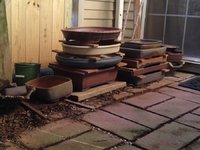Thundie
Sapling
Basically working with someone who is great with ceramics and they're willing to teach me about it as we both try and learn bonsai pots.
I'd use my pots but most of mine are quite cheap ones until I get better/build nicer trees.
So yea looking for advice on things like wall thickness, I've read it's between 1-3cm, is that correct? Would also love some websites and direction of places to buy higher quality pots/browse to gain inspiration and learn the fine details of good pots.
Any help would be much appreciated.
I'd use my pots but most of mine are quite cheap ones until I get better/build nicer trees.
So yea looking for advice on things like wall thickness, I've read it's between 1-3cm, is that correct? Would also love some websites and direction of places to buy higher quality pots/browse to gain inspiration and learn the fine details of good pots.
Any help would be much appreciated.




